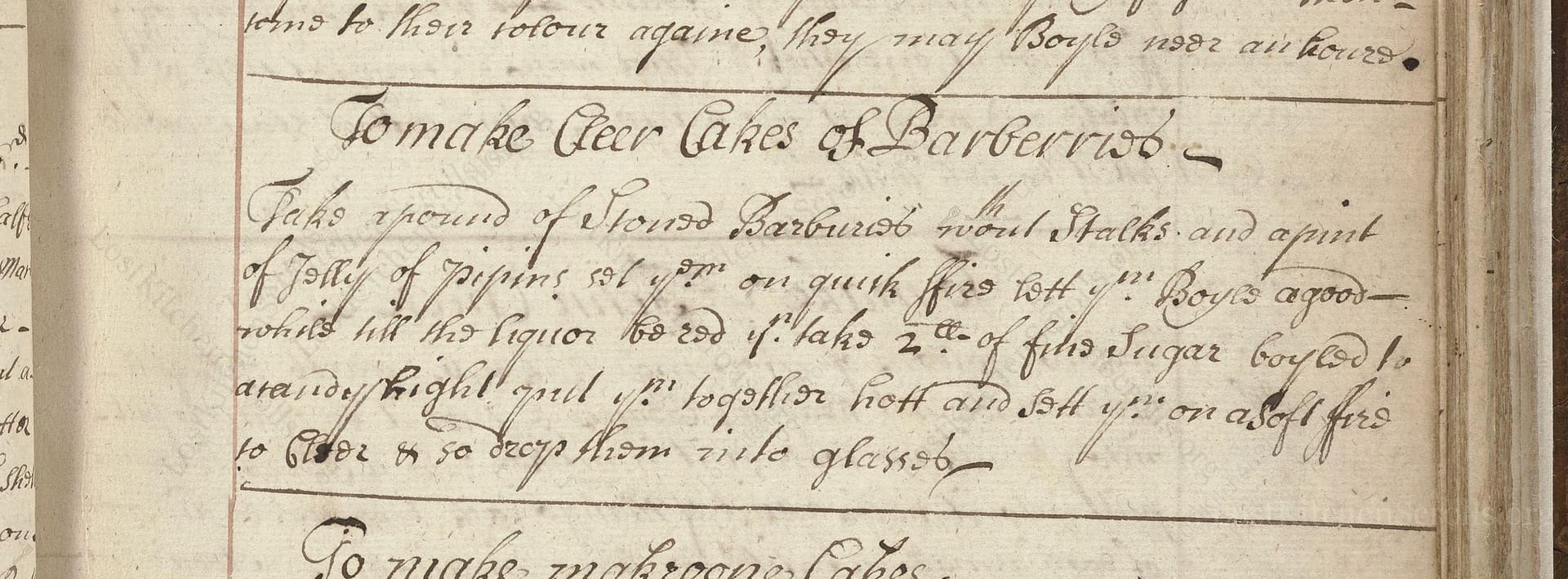To Make Cleer Cakes Of Barberrise
From the treasured pages of Cookbook of Grace Blome, Kent
Written by Grace Randolph

To Make Cleer Cakes Of Barberrise
"Take a pound of Stoned Barberrise with the Stalks and a pint of Jelly of pipins set ym on a quick fire till ye Boyles agoodwhile till the liquor be red yr take a handey hight and put ym together to Cleer on a soft fire then take 2lb of fine Sugar boyled to a hott and soft yr on a soft fire so dropp them into glasses"
Note on the Original Text
The recipe showcases the use of phonetic and period-typical spellings—'Cleer' for clear, 'Barberrise' for barberries, 'ym' for them, and 'boyles' for boils. Instructions were written as a continuous series of actions, with minimal punctuation and no explicit measurements beyond weights and volumes, expecting the cook to supply intuition and experience. Much is left unsaid, as recipes assumed a base level of cookery knowledge—so sugar stages (like 'to a hot and soft'), clarification steps, and equipment were at the discretion of the experienced cook.

Title
Cookbook of Grace Blome, Kent (1697)
You can also click the book image above to peruse the original tome
Writer
Grace Randolph
Era
1697
Publisher
Unknown
Background
A delightful glimpse into late 17th-century kitchens, this culinary collection by Grace Randolph tempts taste buds with refined recipes and elegant flavors fit for a well-to-do English household. Journey through a banquet of historic treats and timeless techniques!
Kindly made available by
Folger Shakespeare Library
This recipe comes from the late 17th century, specifically from the collection of Grace Randolph, penned in 1697. During this time, elaborate fruit pastes and clear jellied sweets, especially those featuring unusual fruits like barberries, were the height of fashionable culinary achievement among England’s upper classes. Jellied confections like 'Cleer Cakes' were prized for their clarity, jewel-bright appearance, and their ability to preserve fruits beyond their season, making them a showstopper on banquet tables and at festive occasions.

The original confectioner would have used a heavy-bottomed copper or brass preserving pan for boiling the fruit and jelly, a strong wooden stirring spoon, a small sieve or fine muslin cloth for clarifying, and a simple sugar thermometer (or cold water test) to judge syrup stages. For molding and setting, small glass tumblers or palatial shallow molds would display the cakes’ clarity and color. Gentle, constant heat was key, often provided by a wood or charcoal hearth.
Prep Time
20 mins
Cook Time
40 mins
Servings
12
We've done our best to adapt this historical recipe for modern kitchens, but some details may still need refinement. We warmly welcome feedback from fellow cooks and culinary historians — your insights support the entire community!
Ingredients
- 1 pound (16 ounces) barberries (fresh or frozen, seeded; substitute cranberries or red currants if unavailable)
- 2 cups (16 fluid ounces) apple jelly or homemade apple pectin (from tart cooking apples, clarified)
- 2 pounds (about 4 cups) fine granulated sugar
- Water (as needed for dissolving sugar)
Instructions
- Begin by taking 1 pound (about 16 ounces) of barberries, ensuring they are seeded and, if possible, including a bit of the tender stalks for flavor.
- Combine these with 2 cups (about 16 fluid ounces) of clarified apple jelly or homemade apple pectin (from tart apples works best for setting), and place the mixture over a medium-high heat.
- Allow it to come to a brisk boil until the liquid turns a vibrant red; this extracts color and flavor.
- Next, take the pan off the heat and pour the fruit and jelly through a fine sieve or cheesecloth from a safe height back into a clean pan, helping to clarify the syrup.
- Return the clarified mix to a gentle heat.
- Separately, prepare a sugar syrup by boiling 2 pounds (about 4 cups) of fine granulated sugar with just enough water to dissolve—heat until a 'soft ball' stage (about 234–240°F/112–115°C), where a bit dropped in cold water forms a soft but stable ball.
- Quickly stir the hot syrup into the clarified barberry-apple mixture, then allow it to simmer gently until thickened and glossy.
- Finally, spoon or drop the mixture into small decorative molds or glasses to set and cool, creating sparkling, jewel-like candied jellies.
Estimated Calories
220 per serving
Cooking Estimates
You will need about 20 minutes to prepare and seed the barberries, then around 40 minutes for cooking, boiling, and simmering the mixture until it thickens. Each serving has about 220 calories, and this recipe makes about 12 servings.
As noted above, we have made our best effort to translate and adapt this historical recipe for modern kitchens, taking into account ingredients nowadays, cooking techniques, measurements, and so on. However, historical recipes often contain assumptions that require interpretation.
We'd love for anyone to help improve these adaptations. Community contributions are highly welcome. If you have suggestions, corrections, or cooking tips based on your experience with this recipe, please share them below.
Join the Discussion
Rate This Recipe
Dietary Preference
Main Ingredients
Culinary Technique

Den Bockfisch In Einer Fleisch Suppen Zu Kochen
This recipe hails from a German manuscript cookbook compiled in 1696, a time whe...

Die Grieß Nudlen Zumachen
This recipe comes from a rather mysterious manuscript cookbook, penned anonymous...

Ein Boudain
This recipe comes from an anonymous German-language manuscript cookbook from 169...

Ein Gesaltzen Citroni
This recipe, dating from 1696, comes from an extensive anonymous German cookbook...
Browse our complete collection of time-honored recipes



